Series #2 Interpersonal Neurobiology Science Chats with Timestamps
$149 for the tea time science chats or $20 each (I recommend this to get started to learning the 9 domains, because each science chat focuses on the WHY, why learn about THAT particular domain, why it is useful, WHY it is interesting)
1. https://vimeo.com/529167090 1st Domain Consciousness
2. https://vimeo.com/535611236 2nd Domain Horizontal
3. https://vimeo.com/546990313 3rd Domain Vertical
4. https://vimeo.com/553030403 4th Domain Memory
5. https://vimeo.com/558699253 5th Domain Story
6. https://vimeo.com/567176906 6th Domain State
7. https://vimeo.com/572863268 7th domain (*POSSIBLY THE BEST one in the series on relationships, attachment, and how the circuitry of consciousness and social engagement overlap and mirror each other)
8. https://vimeo.com/541846863 8th Domain Time
9. https://vimeo.com/578988232 9th Domain Identity
More creative and interactive (less academic) course covering the 9 Levels of Integration
What are the 9 Levels? Read about Series #1 for more information
—————————————————————————-
FIRST DOMAIN: 1st Level Consciousness Science Chat
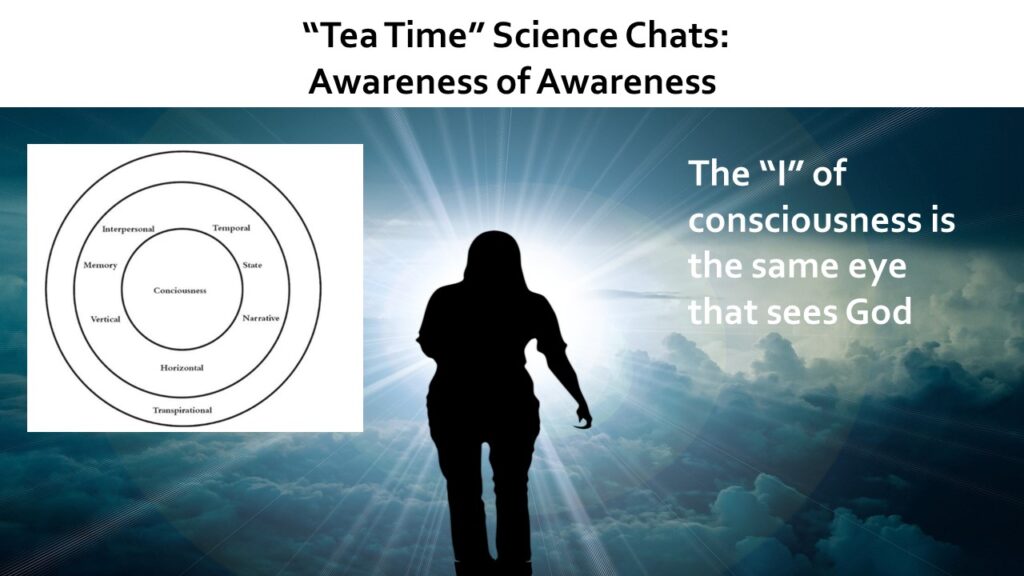
1. https://vimeo.com/529167090 1st Domain Consciousness
Timestamps (links show up after you purchase the class):
Breakout room or journaling questions
To start ask yourself:
1. What are you aware of and what about awareness interests you?
(min 4:30)
2. Pause the recording and answer “What is the knowing and what is the known?”
(min 13:00)
3. Name some different types of awareness?
(min 25:00)
4. Describe how your attention goes from your subjective experience of “awareness of Awareness,” (unconditional love/God in the “Plane of possibility” neuroscience model discussed,) how your awareness goes from that inside to another person’s ears, how do you communicate that experience or state of mind that Brigitta calls it, using that SOCK model.
(min 34:50)
5. How you go from the known to the knowing, specifically, how do you go from reactive mode, overly focused on one thing, to response flexibility wider calmer awareness? (Min 47:00) was a question about how the left and right hemisphere are involved in awareness, (the recording didn’t pick-up the original question).
Key themes were overall,
(min 32:00) 1. How awareness can change the function and structure of the brain
2. How do I share my subjective experience of “awareness of awareness” to another person (audience member’s words for awareness of awareness were God/unconditional love.)
3. Using awareness to focus on what is meaningful in life
4. Neuroscientific explanation for intuitive awareness, awareness of time passing, other types of awareness
5. Additional practice exercises you can pause the video and do in a journal or with a friend like (min 42:18) peripheral vision focus
Crockett has a 3 hr course that teaches on the 1st Domain: Integration of Consciousness; today’s science chat is a group discourse on the fascinating aspects on it. If you are new to this model and want to learn more, the 9th Domain class does a marathon 2 hour 11 min review of all 9 Domains: greenlightheidi.com/2020/08/9th-domain-identity-integration/ Email [email protected] to purchase either the 1st or the 9th Domain courses.
—————————————————————————-
SECOND DOMAIN: 2nd Level Horizontal Integration Science Chat
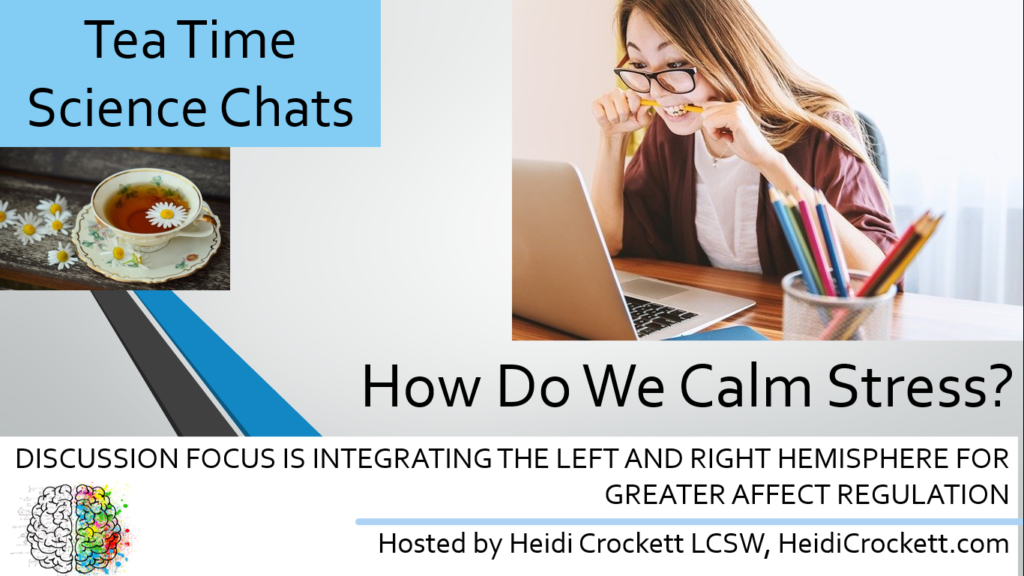
2. https://vimeo.com/535611236 2nd Domain Horizontal
Timestamps:
JOURNALING EXERCISES (or answer the questions with another person watching)
Write down your initial stress level as the class starts from 1 no tress to 10 high stress
1. Min 01:25 ask “When you experience stress describe the sequence of what happens to you?” (from being first aware of the stress, to high stress, to when it starts to resolve, what are the logical, linear steps that happen for you) [LEFT HEMI FOCUS]
2. Min 05:21 Think back to that stress sequence you just recalled but this time describe it with colors and gestures and images and movement and tone of voice like you are talking to a 5 year old [RIGHT HEMI FOCUS]
3. Check your stress level now after doing the two exercises–[see Min 12:19 PowerPoint explanation how differentiating (separating) one hemisphere function, then the other hemisphere function helps to integrate them and leads to calmer mood–audience member at 11:31 did this and shares her experience of feeling calmer]
TIMESTAMPS CONTINUED
06:07 Doing these types of things (gestures, fresh metaphor, etc.) allow you to more be in the right hemisphere’s mode of processing
9:51 Why we tend to extra hang out in the left hemisphere
15:00 Three brain regions (called “regulatory circuits”) that are super valuable real estate (today’s focus is the corpus callosum, the bridge that connects to two hemispheres). To improve integration grow the integrative fibers in these three, the result is more focus, calm, becoming happier, more flow. Tips are at minute 39:43
15:17 See red in the brain where the corpus callosum is
15:54 to 17:58 The left hemisphere’s mode of processing
JOURNAL CONT’D
4.After hearing what the left hemisphere does, set a timer for 5 minutes and write down what you just learned and think of examples in your life where you are using your left hemisphere
TIMESTAMPS CONT’D
20:24 Explanation about the two hemispheres*** and how to describe them in a way that reflects the science, i.e. the brain is always seeking to come together and work as a whole, and there is a way of being or a mode of processing for each hemisphere that reflects a 300 million year old asymmetry. What is happening due to sophisticated brain imaging is that the left hemisphere can be activated and shutting down a function inthe right hemisphere and that shows up as activation in the left and the right hemisphere, so that is one small example how it hard to talk about the topic of the differences between the two and how to apply them in everyday life.
***Heidi recommends watching her 3 hour COURSE on the 2nd Domain for a much deeper explanation of this topic, today was VERY BRIEF: greenlightheidi.com/2020/05/2nd-domain/ (Part 1) and (Part 2) greenlightheidi.com/2020/05/2nd-domain-part-2/
22:34 to 25:40 Right hemisphere explanation
25:21 This comment about the importance of the right hemisphere, mindsight and attachment longings becomes explained better in her WIZARD BRAIN series specifically the classes on mindsight (insight empathy morality,) the class on morality and the class on intuition–scroll to the very bottom of this page to see wizard brain classes: greenlightheidi.com/classes-for-purchase/
JOURNAL CONT’D
5. After hearing about the right hemisphere, set a timer for 5 minutes and write down what you just learned and think of exmaples in your life where you hang out in a more right hemisphere way of being
6. Which is easier to do? (right or left mode?) Which do you prefer? What can you do to strengthen the weaker one? (Tips are at 39:41)
TIMESTAMPS CONT’D
29:25 When you are stuck in your thinking, suggestion on how to shift attention and have a new relationship with that stuckness
OVERVIEW:
Heidi leads a fun and informative jam-packed hour on laterality based on her official SERIES 1 Interpersonal Neurobiology Fundamentals: 2nd Domain Bilateral Hemispheric” course greenlightheidi.com/2020/05/2nd-domain/ She walks you through a series of exercises you can do journaling on your own or paired with someone else.
—————————————————————————-
3. THIRD DOMAIN: 3rd Level Vertical Integration Science Chat
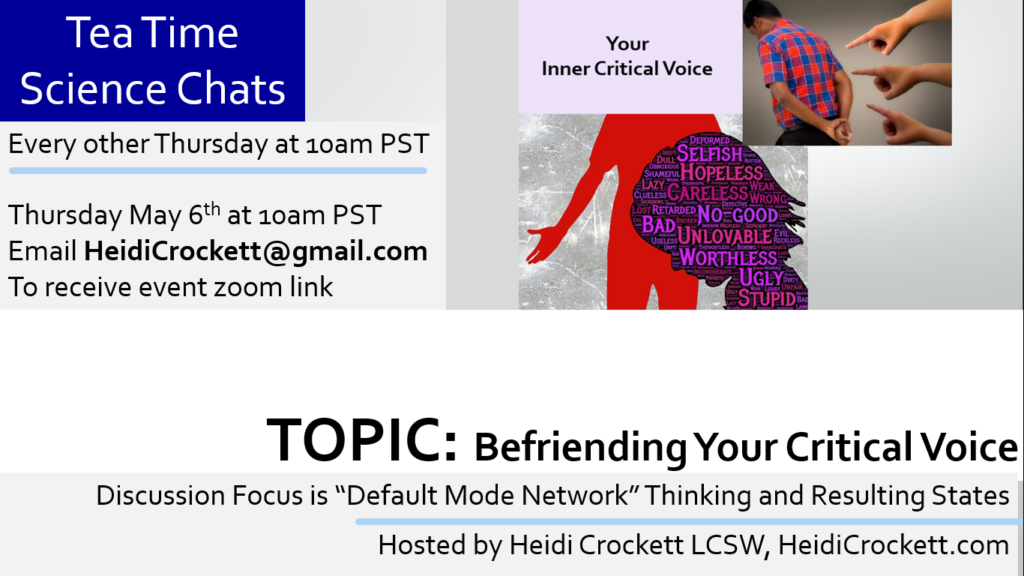
https://vimeo.com/546990313 3rd Domain Vertical
Overview:
Excellent 75 minute class on what is going on in your brain when you feel shame or have the destructive inner critical voice talking to you inside your head. The last 15 minutes includes a definition of dissociation in interpersonal neurobiology (minute 55:00), the 3 steps to do when trauma time causes synaptic shadows from the past to be believed by the brain as a real cue of danger occurring now (minute 62:00) [side comment this “synaptic shadow” experience is clinically sometimes referred to as “trauma time” because implicit memory isn’t tagged with time by the brain, which means your brain gives you the trigger as sensations in the body i.e. tightening in the throat instead of telling you “this tightness in the throat relates to a fear state you were in when your Dad screamed at you when you were 8 years old].
—————————————————————————-
FOURTH DOMAIN: 4th Level Memory Integration Science Chat
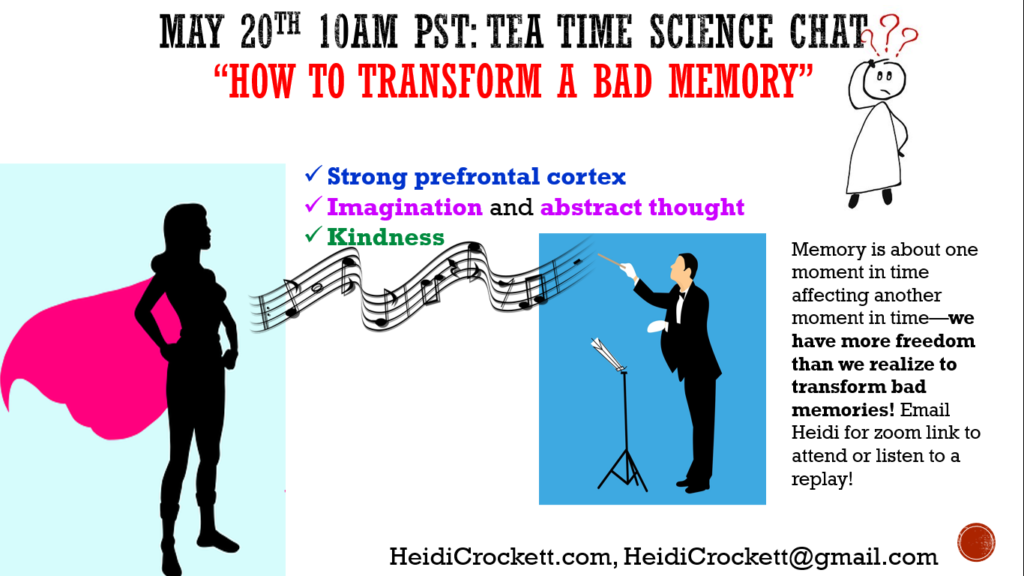
Timestamps:
0:30 The reason WHY you’d want to learn the science of memory change
1:10 Memory change is about sorting through the “coal” of the bad memory and finding the diamond
2:00 Overview of 3 Practice Exercises you’ll complete in the today’s event
2:30 The 1st Practice Exercise to do (either on your own journaling or if you are watching this video with someone else complete in pairs)
2:45 The crucial component to pay attention to when aiming to crate memory change
3:00 The #1 most integrative function that your brain can perform
4:30 When you are triggered, the synaptic shadows of your past flash through your present day awareness, (this is sometimes referred to as “trauma time,”)
5:38 One happy memory from an audience member including feelings and sensations
6:30 Explanation about how your brain is never ONLY completing 1 Domain out of 8 in #IPNB Interpersonal Neurobiology, but rather, each Domain is like a spinning plate or a magical skillset that simultaneously spins and is on-going (plates are technically “processes,” where each Domain is an on-going process,)
7:00 The main #IPNB goal for this hour to optimize your memory
7:50 How making the choice to retrieve a happy memory when your brain COULD retrieve a bad memory is at the heart of what is called cultivating “response flexibility” and bringing executive function/wizard brain thinking online
08:00 Heidi’s overall teaching goal in these science chats is how you can use your wizard brain to change your past and automatic lizard thinking
8:50 What the most recent research says about how many things working memory can hold at any one time
9:20 Different types of memory and the takeaway to know about memory in order to nullify the charge from bad memories and achieve memory change
10:20 What is important about memory according to #IPNB and #IPNB’s framework to improve well-being
10:50 is the 2nd Practice Exercise which asks you to recall a (bad) memory that you want to have a different relationship with and includes specific instructions about what to pay attention to as you recall the memory and why
11:23 an audience member self-reports after experiencing 5 minutes of memory change with Heidi in a breakout room
12:54 Heidi explains the 3 steps she did to help her have a memory change experience, (NOTE: these 3 steps are also part of the “Somatic Experiencing” trauma treatment model,)
STEP 1 Recall of the difficult memory
STEP 2 Slow down time to allow for the client’s wizard brain to more come online and help her become more present
STEP 3 Cultivate a relationship with “the remembering self” vs “the remembered self,” (the more simplified language for these today are your “storyteller” and “story,”)
13:30 Besides the 3 steps, Heidi names one core component that helps anchor the memory change process
From 14:02 – 21:05 an audience member shares her difficult memory and Heidi walks her through a memory change process, (IMPORTANT 19:22 the audience member acknowledges experiencing kindness which is one of three crucial ingredients for the recipe of creating a successful memory change experience–see 52:38 for an explanation of this “kindness” called the social engagement system,)
21:10 Explaining the storyteller vs the story (SEE 33:00 for the slide that has the definition of these two) and an explanation why how you are feeling right now strongly influences whether you’re able to create memory change
21:55 Why it is important to be extra careful when recalling a bad memory, how recalling it can lead to a negative neurohormonal, biochemical cocktail, and Heidi’s tip why kindness is super important [32:38],
An audience member is triggered from 24:00 to 31:35 with an excellent grounding exercise
Fascinating brain science from 27:48 to 29:40, next is 31:38 the definition of a triggered brain in #IPNB–deficits in differentiating and/or linking means there is impaired integration
30:58 attention is either focal or non-focal, and pulled or guided, the weaker the prefrontal cortex the more attention is pulled by strong emotions
31:09 Learning information is secondary in these science chat events, what is to EXPERIENCE the teaching ideas
32:06 the more academic course teaching memory is here greenlightheidi.com/2020/06/4th-domain-memory-integration/ and the EXCELLENT paid class teaching memory change for general audience is here greenlightheidi.com/2020/04/paid-class-self-transformation/ email [email protected] for codes and payment
32:50 the main takeaway to remember about memory
3:03 Storyteller vs story slide
33:20 Besides differentiating (separating) and linking the storyteller and story to achieve a higher state of integration, you can access the social engagement system (which has to do with what is called the “ventral vagus nerve”) (Side comment: Dogs, cats, and horses are all mammals that have a ventral vagus nerve and can help our social engagement systems coregulate and calm down).
—————————————————————————-
FIFTH DOMAIN: 5th Level Story Science Chat

5. https://vimeo.com/558699253 5th Domain Story
Overview:
Come learn the latest science about how to create a coherent story. This class is follow-up to last one’s on memory (see 4th level above) which described how we have many memories and how we can nullify the charge of bad memories using the science of memory reconsolidation. This class talks about how ideally our mind takes the many memories and turns them into one coherent story (or not) and how important this function is for overall mental health.
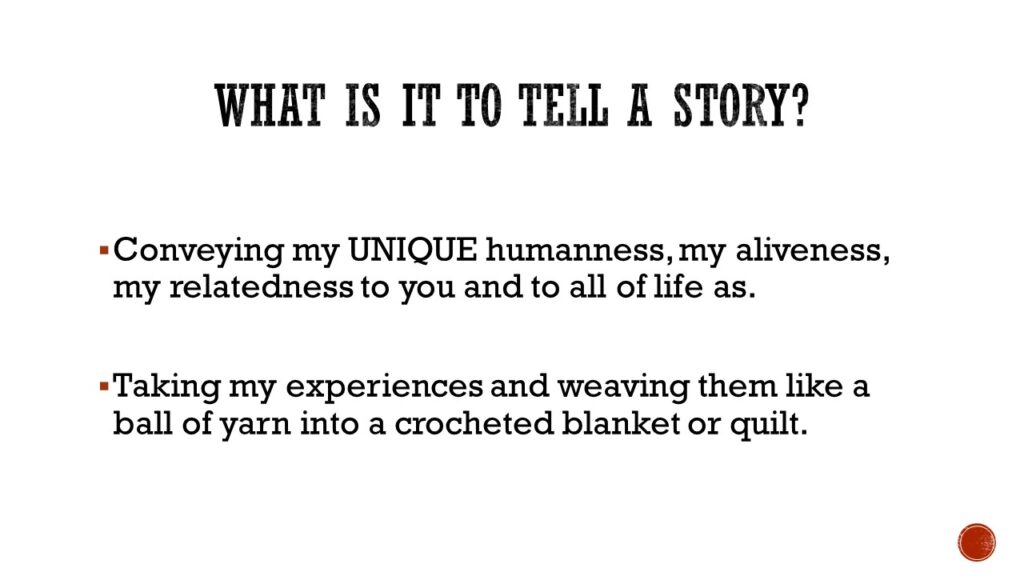
—————————————————————————-
SIXTH DOMAIN: 6th Level State Integration Science Chat
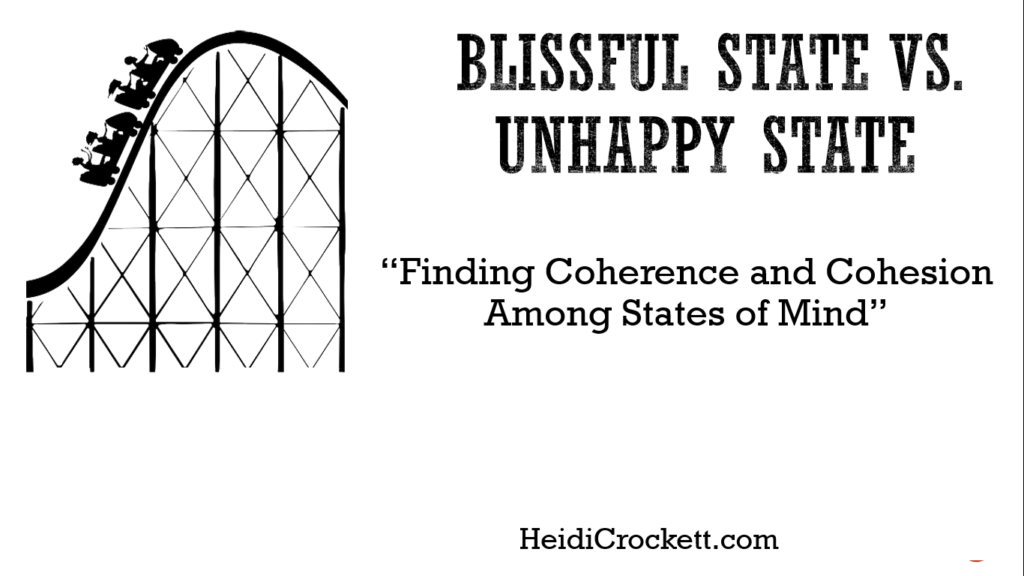
6. https://vimeo.com/567176906 6th Domain State
Timestamps:
0:49 the definition of a state in neuroscience (see slide at 48:40 for written definition)
01:30 quote how research in cognitive neuroscience and adolescent development show various processes in the individual that function “fairly autonomously” with conflicting drives and interests. Heidi then introduces today’s topic “How do we create cohesion and coherence among our many states and processes?” [For more about all these various processes that occur simultaneously (that our nervous system is always seeking to integrate) see 48:51]
2:10 the definition of intrastate integration (see slide briefly at 54:38)
2:47 to 8:00 EXERCISE #1 Heidi walks through an exercise to intensify a mildly positive state (this is called “savoring a state” or Rick Hansen calls it first activating then “installing” a state). This exercise is an example of intrastate integration
8:05 the 3 ways you can integrate a state (see slide briefly at 54:38)
10:44 EXERCISE #2 Heidi asks you to pick a state that you’d like to have a different relationship with. She explains that the goal today is being able to use your wizard brain to monitor and modify your state. That in interpersonal neurobiology you can use your mind to change your brain.
12:00 one audience member sets the goal to change her state
12:32 to 14:04 Heidi walks the audience member and the audience through an exercise to allow audience member to change her state (LISTENER–aim to do the exercise with Heidi)
14:05 to 15:40 These two MAIN tools are MOST helpful to quickly change state–they require you to either self-regulate and/or co-regulate. (See 31:15 explanation of 2 strategies Heidi just used with the audience member, in this explanation are more detailed explanation of these two main tools.)
16:45 START HERE FOR A BRIEF OVERVIEW of the definition of cohesion and coherence and how that especially links to having a healthy attachment style (more healthy relationships)
17:30 Explanation of how a person with more integrate states, when they have more coherence and cohesion, they will experience what is called a FACES flow in interpersonal neurobiology model. Explanation of how a person with less integration goes into rigidity and chaos.
18:25 GOAL of improving our state integration is being able to get out of stuck states (rigidity) and when a state is less integrated usually there is a charge associated with it. (See her class on the 4th level science of memory change vimeo.com/553030403 to learn about nullifying that charge for greater integration.)
19:20 more negative emotions in general relate to lower levels of integration (heading to more chaos and/or rigidity) whereas positive emotions relate to that FACES flow from 17:30
19:40 to 20:40 EXAMPLE of cohesiveness among competing states (when a person has a goal of public speaking and has a state of excitement/passion and has a state of fear about it, she explains how those two competing states can either create or prevent cohesion)
20:54 to 24:50 This section works with shame and embarrassment states
——-
20:54 An explanation for more lizard ways of thinking (referred to as “default mode network” and shame during today’s class. (For more information see her EXCELLENT lizard vs wizard class vimeo.com/583521585 email HeidiCrockett at gmail.com to purchase.)
21:22 Heidi explains one strategy to work with embarrassment
22:18 to 24:10 Audience member is guided by Heidi to integrate shame/embarrassment
24:15 Heidi explanation for the above
———
25:00 EXERCISE #3 Evoke an experience of hope, then evoke an experience of hopelessness
26:38 The audience was mostly able to stay in hope even when visiting hopelessness, this demonstrates an important concept called “having a wide window of tolerance” or what Heidi calls “having a big, wide swimming pool.” She then gives the technical definition of this.
27:30 to 29:30 AUDIENCE MEMBER initial share being triggered
29:51 First strategy to help the audience member integrate her state
30:16 Second strategy
31:15 Explanation for the above 2 strategies. The audience member reports a higher level of integration (calmer, more of that FACES flow). Deeper explanation of the 2 MAIN TOOLS that get a person “up their ladder” (see ladder video here youtu.be/4Gdn3QhGSog?t=216 ) and having a big, wide swimming.
33:42 Resource #1 to help with co-regulation
34:19 Recourse #2 to help with co-regulation
36:00 The 3 gifts of the wizard brain that are MOST NEEDED in order to integrate your states and go up your ladder and get to more of that FACES flow
37:46 Audience member shares hope and hopeless states evoked from EXERCISE #3 at 25:00
38:47 Heidi reply how his share represents a type of integration the way he spoke and mentioned synergy
min 39:15 to 41:00 An overview of synergy and higher levels of integration
NOTE: If you like this science chat subject, Heidi has a more detailed academic course for purchase: greenlightheidi.com/2020/07/6th-domain-state-integration/
—————————————————————————-
SEVENTH DOMAIN: 7th Level Attachment / Relationship Integration Science Chat
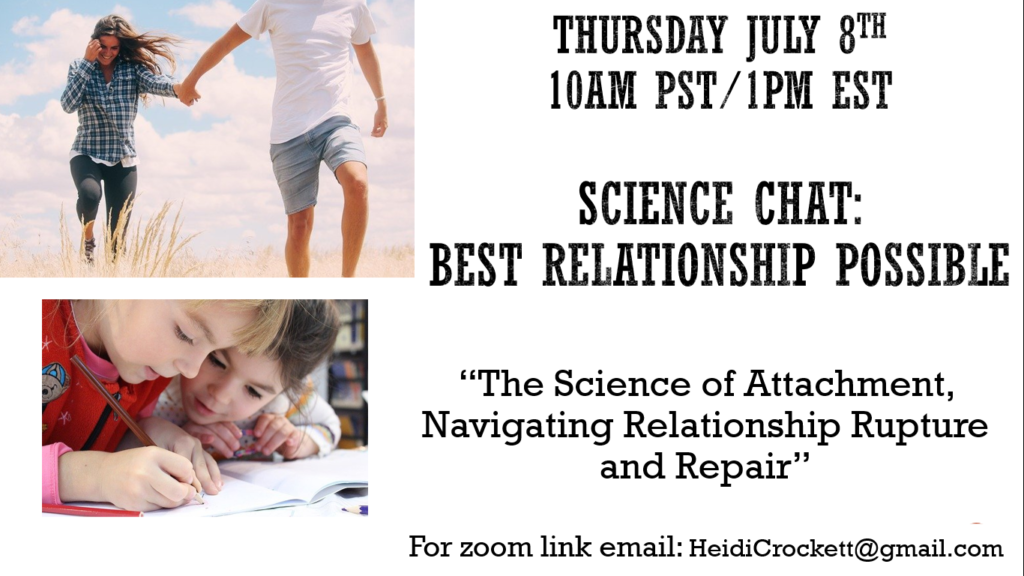
7. https://vimeo.com/572863268 7th domain (*POSSIBLY THE BEST one in the series on relationships, attachment, and how the circuitry of consciousness and social engagement overlap and mirror each other)
Timestamps:
Probably Heidi’s most important science chat converging the intersection between consciousness and the social circuitry of the brain, (see slide at min 21:34 and then exercise looking at the 1st Domain Consciousness** and 7th Domain Relationship, what robust and flavorful experiences of these feel like). **Consciousness science chat (1st Level at the top of the page) vimeo.com/529167090
Related quote “How you relate interpersonally has everything to do with how you relate intrapersonally” (29:45).
This class looks at the qualities that make a healthy relationship (min 18:25 – 19:45) formally called “interpersonal integration” (definition for this at min 7:56) in interpersonal neurobiology. It explores how the mind monitors and modifies (30:00) and how mind-brain-relationships are like a triangle steering wheel of a boat taking each of us and all of us collectively down our river of neural integration (min 20:45).
The main theme is around how mindfulness traits and an adult’s security of attachment are often correlated, how the skills achieved in an integrated 3rd Domain (integrating the lizard brain and the wizard brain, having the ability to regulate which means to monitor and modify,) translate into successfully integrating the 7th Domain relationships (17:19).
Practice exercises to apply the material in your life, (can be done alone with journaling or with another person)–1st exercise 10:05, 2nd exercise at 31:32, 3rd exercise 34:30, bonus journal activity 33:43, 4th exercise 36:00, 5th exercise 47:47, 6th exercise 48:25, 7th exercise 52:30, and a bonus exercise journal about 52:52 to anchor your understanding of your answer to the 7th exercise.
36:21 – 28:15 audience example of circumnavigating relationship rupture and repair
39:45 Heidi explains how this audience member’s example describes 4 components of healthy attachment (see powerpoint overview 1:05:05 to 1:12:50)
48:22 Further explanation about how the audience member’s above example answers 5th exercise which was how when you experience relationship rupture and REPAIR on the other side, how that translates into honoring differences and caringly connecting
39:11 tip to slow down the lizard brain and get the wizard brain present
39:55 contingent communication is mentioned for definition see 1:11:28
34:40 how learning relationship repair is at the heart of healing your attachment style and your attachment as a process
50:43 Main advice about completing relationship repair
51:31 Tip when relating to someone who is more in their lizard brain
42:36 Mary Mane’s decades of research shows these two behaviors are needed to achieve an earned secure attachment in adulthood (even if someone had poor attachment style from childhood)
43:34 Definition of an earned secure attachment
43:41 to 46:03 Heidi walks the audience through an embodied exercise teaching the 4 styles of attachment–secure, insecure avoidant, insecure ambivalent, insecure disorganized
54:34 to 55:12 audience member describes her experience navigating relationship rupture and repair
55:36 Heidi’s experience of rupture and repair with her husband passing away in 2009
58:22 QUICK EXPLANATION what it looks like to get through to the other side of relationship rupture and do the internal work to achieve a relationship repair (when the other person isn’t there)
59:55 to 1:00:20 How Attachment Style from childhood is like a pair of colored glasses where the “color” is those 4 metaphors from exercise at min 43:41
1:02:16 Attachment Style vs Process (VERY IMPORTANT concept)
1:02:25 How the heart strings of Attachment Style get twanged with loss-see 8th Domain science chat time integration making sense of mortality vimeo.com/541846863
59:22 to 1:15:36 The PowerPoint explanation of attachment and interpersonal integration
1:16:00 IMPORTANT DEMONSTRATION Audience member initial 30 sec explanation of issue with her mother, then client’s charge and resulting intervention kind voice (detailed strategy taught in 3rd Domain science chat (3rd level closer to the top of this page) as a way to calm lizard and bring wizard brain online vimeo.com/546990313) and science of healing shame is discussed, then 1:20:00 demo moves to discussing honoring differences between client’s issue AND her love for her mother with Heidi explanation 1:21:53 solution is around client having big wide swimming pool and 1:23:03 bringing in what is called “mismatch experience” in memory reconsolidation science or layperson term “the missing ingredient” (detailed explanation for this at science chat vimeo.com/553030403 and her youtube youtu.be/dRD8bwmMA3s?t=273) so that 1:23:03 until 1:25:08 is another example of how to achieve relationship rupture and do the REPAIR on your own even if you cannot get resolution from the original person.
1:26:15 FINAL COMMENT the power and hope that comes from healthy relating and showing care
1:12:52 to 1:15:36 End of the powerpoint explaining what is required to successfully integrate in relationship and achieve the 7th Domain
—————————————————————————-
EIGHTH DOMAIN: 8th Level Time / Temporal Integration Science Chat
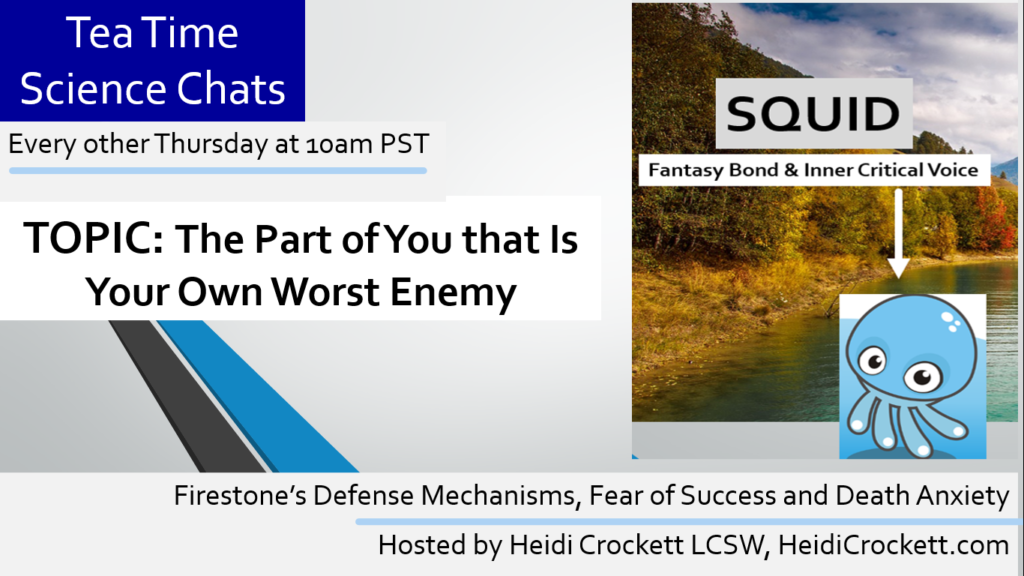
8. https://vimeo.com/541846863 8th Domain Time
Timestamps:
Which wins out in your decision-making process–the lizard brain or the wizard brain? Heidi walks audience members though 5 possible exercises to help integrate these two parts. She begins asking for a success, then a moment of failure, then has 3 more exercises. At min 31:00 and min 41:00 she outlines a theory from Dr. Robert Firestone about two core defense mechanisms that develop in response to the pain of living, then ties these to interpersonal neurobiology concepts of integrating uncertainty and time (which is the 8th Domain and about how we make meaning in our lives). Basically, our brains develop ways to cope with pain–either our coping mechanisms can involve more connection and making sense of life through a well-integrated prefrontal cortex region or they can involve a more “black white” and judging style of thinking which limits the capacity for interpersonal relating. This second way of coping is called the “Anti-Self System” or slang “SQUID.” Heidi gives solutions for wiring your brain up optimally and how to reduce the more primitive reactive regions of the brain from overtaking our thinking. There are examples of traveling from more lizard to more wizard states with audience members.
Time stamps are 1st reflection exercise min 4:51, 2nd reflection exercise min 12:48, 3rd reflection exercise min 33:44, 4th reflection exercise min 35:45, 5th BONUS exercise min 38:45 (Do I hang out in uncertainty or certainty more, which do I need to be with more and how can I better hold BOTH states AND commit to walking forward with my heart open toward my life goals)
Other timestamps:
Min 3:32 What exactly the prefrontal cortex means and why it is core to the process of creating meaning
Min 17:00 to 21:30 after completing reflection exercise #1 and #2 do this integrative exercise with Heidi
Min 25:00 to 27:30 Demonstration how a person enters different autonomic nervous system states, physiological states, but the mind cannot notice the difference shifting between them
Min 28:00 Attention can be focal or non-focal, pulled or guided
Min 30:00 The Solution is to soften around the SQUID, Min 32:30 Psychological equilibrium is like a rubber band. Heidi (using the science of memory reconsolidation) can help you unscramble the mechanism inside you that is unconsciously tightening and maintaining the rubber band.
Min 35:00 overviews the entire theme for today of how the brain makes sense of and is best able to be with the uncertainty (and pain of living) inherent with being alive. Heidi explains how neurobiology defines spirituality min 35:50, how the shared source of consciousness in the interpersonal neurobiology model (the open plane of possibility) is a core part of being able to hold states of uncertainty min 40:00
—————————————————————————-
NINTH DOMAIN: 9th Level Identity Integration Science Chat
BEST VERSION OF YOURSELF
Fantastic 1 hour 40 minute overview reviewing each of the 9 Levels!

9. https://vimeo.com/578988232 9th Domain Identity
Overview:
100 minute class that overviews all the 9 Domains (categories) of neural integration in Interpersonal Neurobiology (IPNB).
2:15 song that demo’s a “MWE” expanded sense of self mentality (just before this Heidi gave a heads up that the first breakout room exercise will be talking about a time in your life where you developed an expanded sense of self/positive shift in identity)
6:20 thinking about the hopeful message coming from the song, how you interpret what that hope means for you and the world in your life story, this points to your 9th Domain integration
6:44 The definition of integration in the 9th Domain
7:30 Answers the question, “What in general are the 9 Domains?” (OVERALL IPNB THEME: at the individual level from many memories to one story, at the collective level from many individuals to one MWE)
**This class is an EXCELLENT INTRODUCTION to interpersonal neurobiology (IPNB,) which if you are reading the IPNB words for the first time just think “integrative neuroscience.”
TIP: After you watch the first 5 minutes, it is recommended that you watch the last 50 minutes where the PowerPoint runs, then go back and go through the exercises and the explanation that Heidi gives during the first half where there are no slides.

Comments